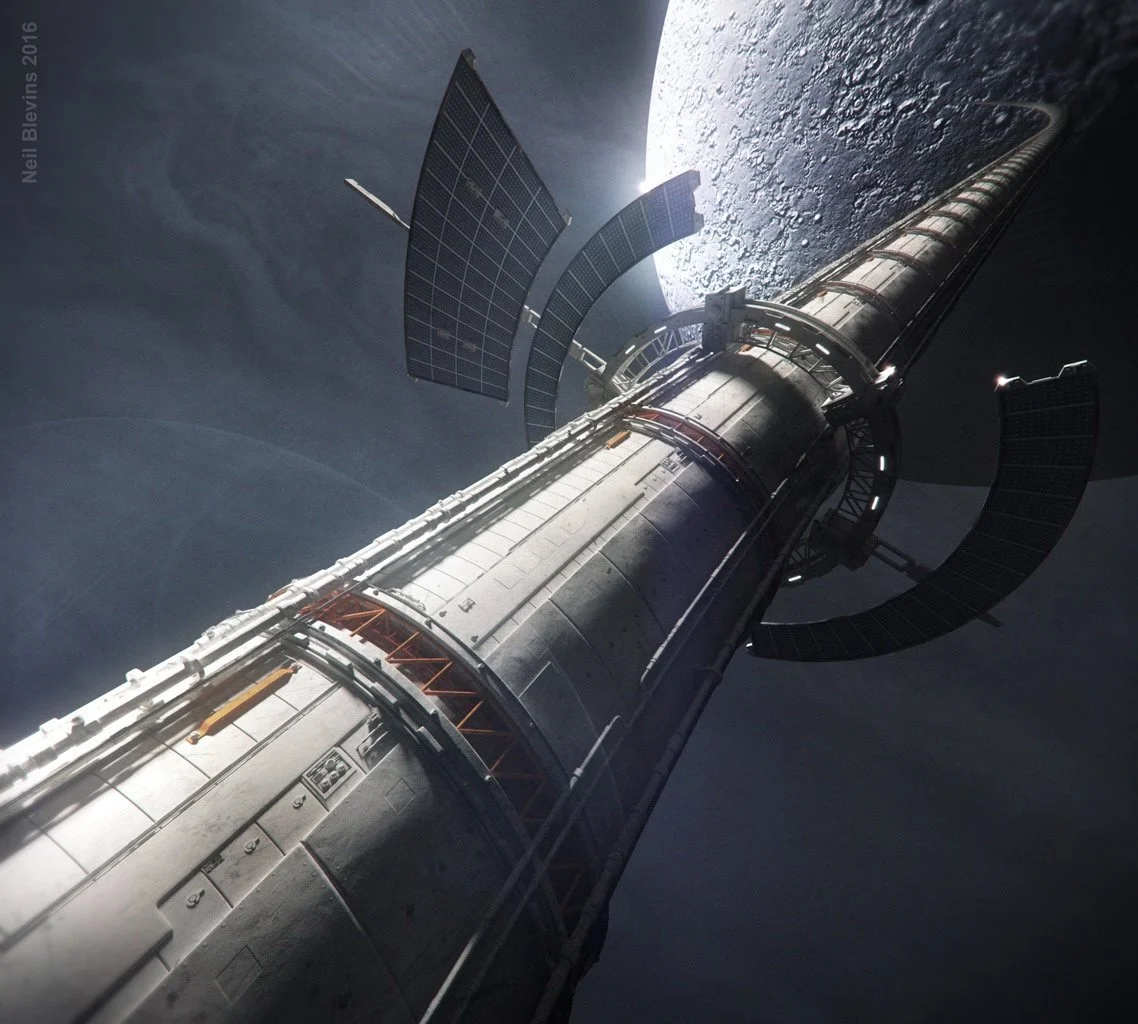The Earth–Moon Highway: Could Elevators Make A Direct Link?
Concept art illustrating a “cable” between Earth and Moon that would allow a vehicle (climber) to travel back and forth, from Earth’s surface to the lunar surface, in order to transport people and cargo across space.
Image credit: Neil Blevins on ArtStation
Why a GEO port plus a lunar elevator is plausible—while a single Earth-to-Moon tether is not
Illustrations sometimes imply a literal lift from an equatorial pier to the lunar surface. The physics and the literature point elsewhere. A single continuous tether spanning atmosphere, Earth orbit, cislunar space, and down to the Moon would face incompatible force regimes, atmospheric drag and weather, and the Moon’s inclined, eccentric orbit—producing large, time-varying loads and resonances with no credible stabilisation scheme. Authoritative studies frame cislunar access as ports plus transfers, not one cable end-to-end.
A feasible architecture looks like a corridor with two lifts and a lobby. On the Earth side, the canonical design is an equatorial Earth Port (envisaged as a floating offshore platform by Obayashi Corporation, a geostationary (GEO) logistics hub at ~35,786 km, and a counterweight extending tens of thousands of kilometres outward to keep the ribbon in tension. This is the baseline in the International Academy of Astronautics (IAA) assessment and earlier NASA Institute for Advanced Concepts (NIAC) work. Obayashi’s public concept mirrors the same elements and puts directional dates and dimensions to them (a 96,000-km cable; ~400-m floating Earth Port; a GEO station), while noting that materials and operations must mature.
At the Moon, a lunar space elevator (LSE) is anchored on the surface and balanced about the Earth–Moon Lagrange points, typically EML-1 or EML-2. Critically, published NIAC work argues that an LSE is materially feasible sooner because lunar gravity is weaker and the ribbon does not cross an atmosphere; high-performance fibres available or foreseen today can meet the strength-to-weight ratios for useful payloads. The LSE functions as a surface-to-space conveyor to the Lagrange node, where cargo hands off to tugs for transfer through cislunar space.
In between sits the GEO Port, the hand-off node for an Earth elevator. Payloads that arrive on the tether can (i) remain at GEO for servicing and assembly, (ii) transfer to high-efficiency orbital tugs for cislunar legs, or (iii) exploit tether mechanics: releasing above GEO imparts useful “throw” (speed-change implications) toward higher orbits, while releases below GEO drop toward low Earth orbit at lower propellant cost. Orbital-mechanics analyses formalise these options and their speed-change payoffs; the port is a logistics hub sized by throughput and safety, not a destination city.
Is a direct Earth–Moon elevator better than rockets? The direct version fails the feasibility test; the paired-elevator network is the realistic comparator. Elevators trade high capital expenditure for low marginal cost per kilogram once cadence is established. A lunar elevator running frequent climbs could beat small, sporadic landers for steady flows—sample return, spares, and volatiles—while rockets and high-power tugs remain essential for time-critical moves and outsized cargo. The IAA’s “system-of-systems” framing is the right mental model: elevators would complement, not replace, launch.
An Earth elevator is the long pole: it waits on tether materials (carbon-nanotube-class strength-to-density), inspection/repair robotics, and governance. The IAA study deems the concept potentially feasible but long-term. Obayashi’s 2050 ambition is best read as directional, contingent on breakthroughs and policy. By contrast, an LSE has lower materials hurdles and a smaller operational envelope; NIAC reports and subsequent papers outline staged demonstrators aimed at science and logistics. A portfolio that funds LSE first, GEO port services second (more tugs, depots, and standards), and Earth elevator last is the sequence most studies imply.
For lunar residents, the network functions as a safety net. If launch windows slip or pads are down, a predictable elevator-plus-tug route still moves medical supplies, spares, and return capsules to rendezvous points. For science, regular sample mail emerges: scheduled down-climbs from the surface to EML-1, on to the GEO Port, then into Earth-entry capsules—higher cadence than bespoke missions. For infrastructure, an LSE can lift liquid oxygen (LOX) and hydrogen (LH₂) made on the Moon to orbital depots efficiently; shipping cryogens to Earth’s surface is far less attractive (re-entry safety and handling), but cislunar depots transform the economics of lunar and deep-space missions that stage from GEO/EML.
Why not wait for better rockets? Launch will remain central. Yet rockets excel at bursts of capacity, not at metered, day-in/day-out logistics. Elevators—once proven—behave more like rail: fixed infrastructure with predictable slots, lower variance in delivery times, and pricing that improves with utilisation. That steady flow de-risks lunar industry planning, while rockets handle peaks, people, and exceptional cargo. The combination—ports, elevators, and tugs working with launch—is the resilience story investors and operators can underwrite.
A prudent roadmap begins with a lunar elevator demonstrator: prove deployment, climber control, ribbon inspection/repair, and station-keeping at the Lagrange node; run a paid sample-return and parts-delivery service to validate economics. In parallel, grow GEO-port services—standard berths, depots, and tug fleets—so hand-offs become routine. Only once materials, inspection robotics, and governance mature should an Earth elevator move from study to programme. The benefit of this sequence is optionality: each step has standalone value even if the next takes longer.
Obayashi’s public materials provide a concrete exemplar of the Earth-side system—floating Earth Port connected by an undersea tunnel to shore, a GEO station, and a long counterweight—plus a set of “gates” (LEO, lunar, Martian) that echo the port-and-transfer logic above. As with the IAA/NIAC literature, the message is modular growth rather than a single monolith: build the port functions sized to throughput, then scale.
A direct Earth–Moon elevator does not survive first contact with dynamics and materials. A paired system—Earth elevator to a GEO Port, plus a lunar elevator to EML-1/2—does. It would not replace rockets; it would stabilise cadence and lower marginal costs where steady flows matter most. If the objective is reliable settlement and science on the Moon, that corridor—two lifts and a lobby—deserves serious study alongside launch vehicles and high-efficiency tugs.
